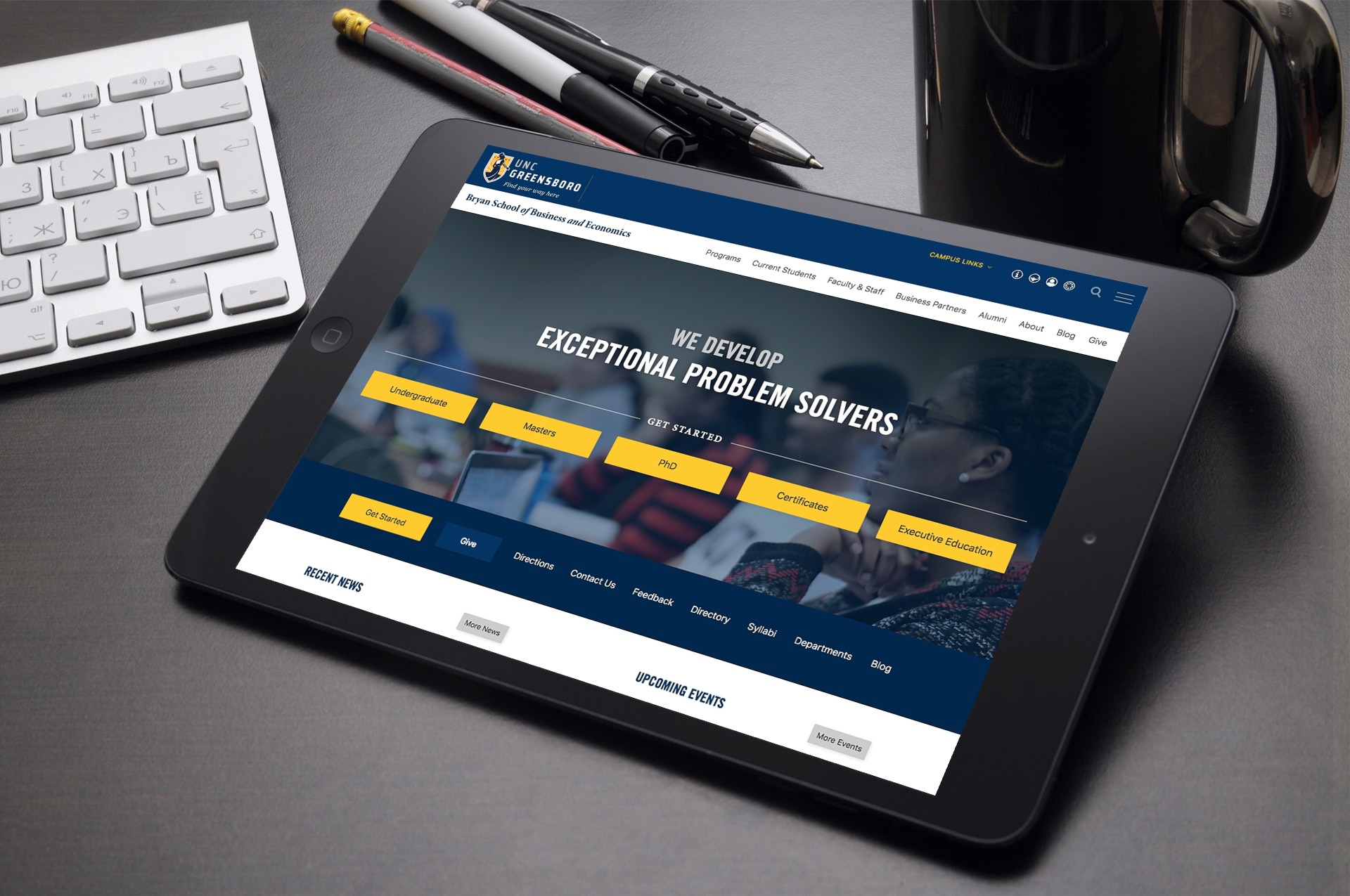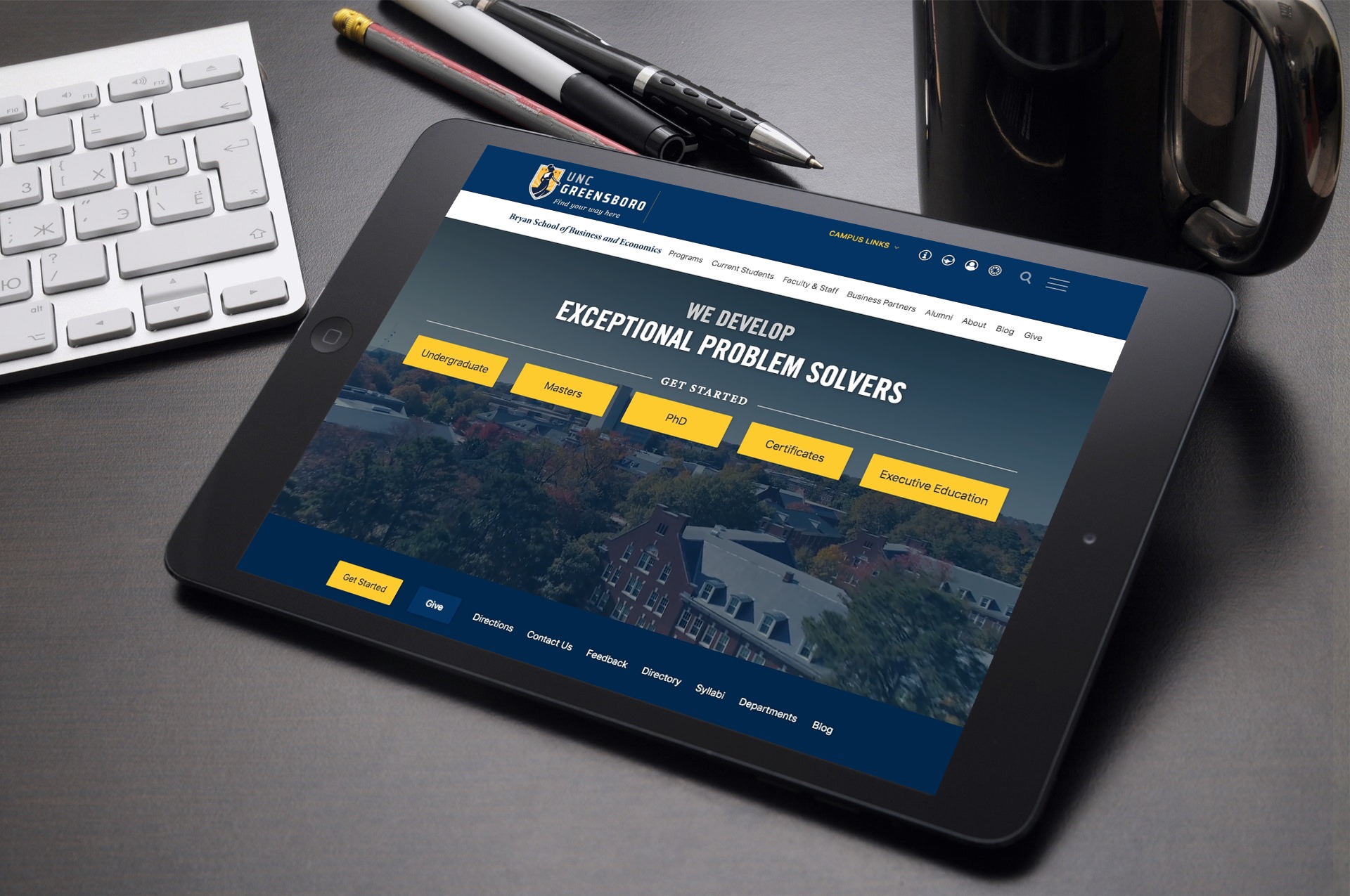Overview
In its website redevelopment RFP, the Bryan School acknowledged that its website was out of date, in a “general state of disrepair” and lacked necessary features – notably mobile responsiveness. A successful redesign would refocus the school’s site on student recruitment, student engagement and faculty and staff involvement. The primary goals were intertwined: first, a fluid and rewarding website that would provide a stunning first impression while reflecting the needs of site visitors and encouraging positive user interactions; and second, for accessibility, user experience, usability, brand awareness and audience-centeredness to be the chief drivers of the site’s build and design. Thirdly, the Bryan School wanted to provide users with rich and engaging mobile access.
In terms of user experience, the Bryan School asked for its site to quickly and effectively direct users to precise actions and desired pages, meaning prospective students, current students, faculty/staff and other users would be required to make fewer decisions to find academic information, schedules, and other critical resources – all within a site that was not only industry standard, but a site with the appeal and feel users would expect from a well-performing company, the kind of company which employed Bryan School graduates.
The Challenge
Because the Bryan School’s existing site’s architecture was built from an inside-out perspective, re-engineering was required to design the site from the audience point of view, looking in.
Achieving the goal of a fluid, responsive site required reorganizing the website’s content under a more consolidated architecture. An added benefit of the new architecture would also make the site completely mobile responsive and cross-platform compliant, ensuring important content was as easy to find via mobile devices as from a desktop.
“We wanted our site to be a competitive advantage for us,” said Alex Runyan, the Digital Marketing Specialist/Web Administrator for the Bryan School, who was tasked with the responsibility of leading the redesign of the school’s website by the dean’s office. “At the state the website was in, it was a major disadvantage to us.”
Initial Problems
The Verified Solution

First, the site’s entire navigational structure was re-created to be fully user-centric. “Programs,” not “Prospective Students,” became lead choice on the top bar menu for those seeking a bird’s-eye outline of the Bryan School’s academic offerings (complete with links); below it, a newly-created “Get Started” section became the focal point of the page.
From that home page, prospective students can jump directly into their area of interest – whether it be Undergraduate, Masters, PhD, Certificates or Executive Education study pursuits. The result allows those and other users to arrive at their desired page on the site in one or two clicks, compared to three or more on the old site. Visitors now arrive at pages wholly devoted to their needs and see only information relevant to their interests – a pattern Verified replicated on other parts of the new site as well.
Second, the site became highly-engaging across all mobile platforms. Where beforehand, the mobile functionality of Bryan School site was below higher education standards, the new site delivers the same type of user-centric experience that users are getting via desktop or laptop – a critical tool for the school in an environment where more and more users access the site and make critical judgments and decisions from their smartphones.
The ensuing architectural change of the website was one of the greatest benefits resulting from the Bryan School’s redesign, according to Runyan.
“It seems obvious in hindsight,” he said. “Now each section of the site is centered around our different constituencies. That was definitely a paradigm shift in how we were approaching it. It was a very, very good choice, and a good projection by Verified.”
Our Process
Identify what has historically drawn students to the Bryan School, and what sets the Bryan School apart from the competition. Incorporate these elements into the design and aesthetic of the new site so the look and feel appeals to the students and prospective employers of Bryan School graduates.
Determine the needs of the Bryan School's varied audiences. After interviewing dozens of students, alumni, staff and administrators, Verified identified the key information required and designed architecture that facilitated easy access for all audiences.
Build the site with responsive design and user-friendly navigation, taking into account input from the various stakeholders and the requirements of new and returning users.
Using a collaborative approach, migrate content to the new site and train staff with an eye on future needs.
The Benefits
The Bryan School’s site now serves as a recruitment tool for national and international prospective students because it highlights the degrees, programs and accreditations the school offers as well as the navigability and search capability for them – as well as for current students and for faculty, staff and the school’s 24,000 alumni.
In its RFP, the Bryan School said its ability to achieve its organizational goals through its website centered around recruiting and retaining the best and brightest students, staff and faculty. According to Runyan, the new site is accomplishing that. Since the launch, year-over-year analytics show a 25 percent overall increase in unique page views, plus an additional 35 percent overall increase in time spent per page from mobile devices and desktop users.
That impact is measured in significant ways: Bryan’s new site has showed an increase of new mobile users of 30 percent, and that the bounce rate for mobile users had decreased a full 32 percent.
The Future Opportunities
“Verified didn’t just solve our needs for today – they improved the structure of our site in a way that will allow us to grow and improve over the next few years,” said Casey Fletcher, the Bryan School’s Director of Marketing & Communications.
In addition, Runyan said university’s marketing and communications leadership conveyed to him the Bryan School’s new site was now considered “the lighthouse” for the university.
“We have garnered very favorable compliments from throughout the Bryan School and the University for the visual effects and the overall ease of us,” said Joseph Erba, Assistant Dean for External Affairs for the Bryan School of Business & Economics. “The lead executive for the university’s marketing and communications has stated that we have set the standard for the rest of the university. That’s high praise from a senior executive with heavy industry experience.”
Runyan said the experience in working with Verified on the project satisfied his needs as someone who is “kind of a sucker for customer service – the old way of doing things.”
“If I asked for something and I needed it quickly, they would get it to me quickly, or if they couldn’t, they’d let me know right away,” he said. “It’s hard to believe, but a lot of web companies just do not operate like that. I think they get complacent in their skill giving them that competitive advantage and they don’t worry and making sure the client is getting exactly what they want and need.”

